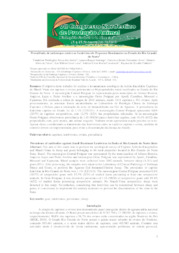Prevalência de anticorpos contra os Lentivírus de Pequenos Ruminantes no Estado do Rio Grande do Norte.
Prevalência de anticorpos contra os Lentivírus de Pequenos Ruminantes no Estado do Rio Grande do Norte.
Autoria: SANTOS, V. W. S. dos; SANTIAGO, L. B.; ALVES, F. S. F.; FARIAS, D. A. de; LIMA, A. M. C.; CAVALCANTE, A. C. R.; PINHEIRO, R. R.
Resumo: Resumo: O objetivo deste trabalho foi realizar o levantamento sorológico da Artrite-Encefalite Caprina e da Maedi-Visna em caprinos e ovinos pertencentes a 66 propriedades rurais localizadas no Estado do Rio Grande do Norte. A mesorregião Central Potiguar foi representada pelos municípios de Afonso Bezerra, Angicos, Lajes e Pedro Avelino e a mesorregião Oeste Potiguar por Apodi, Caraúbas, Mossoró e Upanema. Foi realizada a coleta de sangue de 2042 animais, sendo 1111 caprinos e 931 ovinos. Após processamento, as amostras foram encaminhadas ao Laboratório de Patologia Clínica da Embrapa Caprinos e Ovinos para a realização do teste de Imunodifusão em Gel de Agarose. A prevalência do lentivírus caprino no Estado foi de 1,1% (12/1111). A mesorregião Central Potiguar apresentou 0,6% (3/475) de caprinos soropositivos, com 12,5% (3/24) das propriedades infectadas. Já na mesorregião Oeste Potiguar, observou-se prevalência de 1,43 (9/636) para o lentivírus caprino, com 19,4% (6/32) das propriedades com, pelo menos, um animal reagente. Nenhum ovino apresentou reação positiva no teste. Apesar disso, considerando a transmissão das lentiviroses entre as espécies caprina e ovina, medidas de controle devem ser implementadas para evitar a disseminação da doença no Estado. Prevalence of antibodies against Small Ruminant Lentivirus in flocks of Rio Grande do Norte State. Abstract: The aim of this study was to perform the serological survey of Caprine Arthritis-Encephalitis and Maedi-Visna in sheep and goats belonging to 66 rural properties located in Rio Grande do Norte State, Brazil. The mesoregion Central Potiguar was represented by the municipalities of Afonso Bezerra, Angicos, Lajes and Pedro Avelino and mesoregion Oeste Potiguar was represented by Apodi, Caraúbas, Mossoró and Upanema. Blood samples were collected from 2042 animals, between sheep (1,111) and goats (931). After processing, the samples were taken to the Laboratory of Clinical Pathology of Embrapa Sheep and Goats, to perform the Agarose Gel Immunodiffusion Assay. The prevalence of caprine lentivirus in Rio Grande do Norte was 1.1% (12/1111). The mesorregion Central Potiguar presented 0.6% (3/475) of seropositive goats with 12.5% (3/24) of studied farms presenting at least one seropositive animals. In Oeste Potiguar, it was detected a prevalence of 1.43 (9/636) of seropositive goats with 19.4% (6/32) of studied farms presenting seropositive animals. No Maedi-Visna seropositive sheep were detected in this study. Nevertheless, considering that lentivírus can be transmitted between sheep and goats, it is necessary to implement the sanitary measures to prevent the dissemination of the virus in the State.
Ano de publicação: 2012
Tipo de publicação: Artigo em anais e proceedings
Unidade: Embrapa Caprinos e Ovinos
Observações
1 - Por padrão são exibidas publicações dos últimos 20 anos. Para encontrar publicações mais antigas, configure o filtro ano de publicação, colocando o ano a partir do qual você deseja encontrar publicações. O filtro está na coluna da esquerda na busca acima.
2 - Para ler algumas publicações da Embrapa (apenas as que estão em formato ePub), é necessário ter, no celular ou computador, um desses softwares gratuitos. Sistemas Android: Google Play Livros; IOS: iBooks; Windows e Linux: software Calibre.
Acesse outras publicações
Acesse a Base de Dados da Pesquisa Agropecuária (BDPA) para consultar o acervo completo das bibliotecas da Embrapa.

